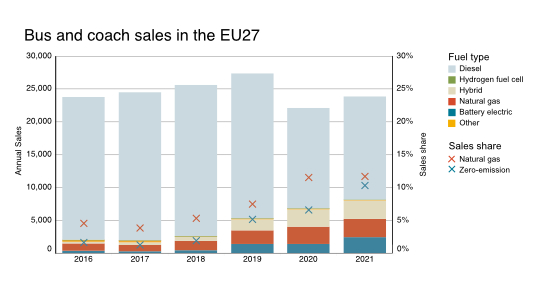
Eamonn Mulholland@EamonnMul
Sep 20, 2022
6 tweets
Buses are the superstars of the energy transition.
They make up 0.2% of vehicles in Europe, but deliver 10% of passenger kilometres. They even have a higher share of zero-emission vehicles than cars.
Our new paper looks out what's driving the change
(1/5)
Buses don't have CO2 standards yet, so demand-side measures are largely driving this trend. Sales shares vary wildly across Member States. In some, electric buses make up close to half of their sales (FI NL
NL DK
DK ). In others, nearly none are sold (GR
). In others, nearly none are sold (GR , IE
, IE , PT
, PT ).
(2/5)
).
(2/5)
 NL
NL DK
DK ). In others, nearly none are sold (GR
). In others, nearly none are sold (GR , IE
, IE , PT
, PT ).
(2/5)
).
(2/5) Cities are showing the most impressive commitment. Over half of Europes' capital cities plan for a fully zero-emission bus fleet by 2040. #Amsterdam and #Copenhagen are leading by example with a 2025 phase-out date.
(3/5)
Major manufacturers have been slow to make the electric switch, with some shifting focus to natural gas, which provides little climate or health benefit. This has opened up the market to lots of new smaller manufacturers.
(4/5)
While they might be slow to electrify, these manufacturers have some big plans for the future. @Daimler Truck AG makes up a quarter of all European bus sales, and plans to only sell electric city buses from 2030 on. @MAN Truck & Bus plans 50% electric sales in 3 years.
(5/5)
Link to paper: theicct.org/publication/th…

Eamonn Mulholland
@EamonnMul
All things climate change and transport. Associate Researcher with the ICCT; previously JRC, MaREI, and Fulbright alum; all views are my own
Missing some tweets in this thread? Or failed to load images or videos? You can try to .




